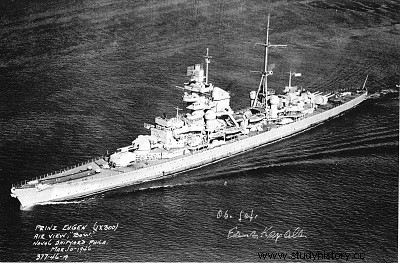
Unless considering pocket battleships as heavy cruisers, Germany did not begin to build ships of this type until the mid-1930s, when the Royal Navy gave up this design. The German Navy had three built and completed, the Hipper, Blücher and Prinz Eugen, a fourth was sold to the Russians, and a fifth was transformed into an aircraft carrier, but the work was never completed. The Blücher was sunk by the Norwegian coastal defenses even before it was fully developed, the Hipper suffered from chronic engine trouble, while the Prinz Eugen, which had been slightly improved over the other two, was the most successful of the series.
The Hipper, like other early heavy craft, was originally given a straight stem and cowlless funnel, but was later modified to resemble her brethren with a jib bow and funnel cowl. All three were powerful ships with strong secondary artillery, good speed and much thicker protection than other 203-armed European cruisers, with the exception of Algeria, the only one to match them. in the British and French Navies.
They would have made excellent ships but for the unreliability of their high-pressure boilers and the short range due to their steam turbines. Indeed, Prinz Eugen held a very honorable place as support for Bismarck against Hood and Prince of Wales; he got hits with his 203s even before the Bismarck's 380s, and his silhouette misled the British, who directed their fire against him.
PRINZ EUGEN
Normal movement , 14,800 t; at full load,
19,800 t
Length 210 m overall
Width 21.80 m at main beam
Average draft , 5.79 m
Propulsion 3 shaft lines, gear turbines, 132,000 hp,
Speed 32 knots
Protection
cuirass belt , 83 mm;
bridge ,38-64 mm;
turrets , 165 mm
Artillery 8 pieces of 203 mm, 12 of 105 mm AA, 12 of 37 mm AA,
8 of 20 mm AA
L.T Tubes . 12 × 533 mm torpedo tubes
Aviation 3 aircraft, 1 catapult
Launched August 22, 1938 at the Germania shipyard in Kiel.
